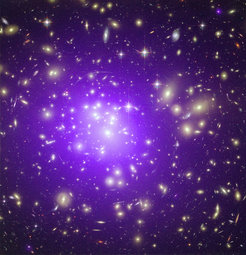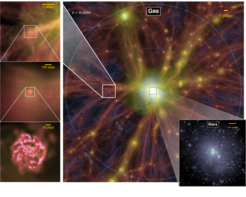The Hydrangea project: high-resolution hydrodynamic simulations of galaxy clusters

The Galaxy cluster “Abell 1689”, located approximately 2 billion light years away, is one of the most massive clusters in the known Universe. This picture is a composite of an optical image, taken with the Hubble Space Telescope, and an X-ray observation with the Chandra Space Telescope. The former shows starlight from more than 1000 galaxies, the latter (in purple) the hundred-million-degree hot gas which permeates the space between galaxies and contributes more mass to the cluster than all its galaxies together.
Galaxy clusters are giant associations of up to several thousand galaxies, embedded in diffuse hot gas and invisible dark matter (see Fig. 1). Observations have shown that these extreme environments influence the properties of the galaxies within: while isolated galaxies often contain star-forming discs where massive young stars shine in blue, cluster galaxies are mostly yellow or red - indicating that they stopped their star formation several billion years ago. Often, these cluster galaxies present an apparently featureless “elliptical” morphology. Understanding the origin of these differences has been a major unsolved problem in astrophysics for decades.
One key reason for this is that galaxies evolve on timescales of millions to billions of years. Astrophysicists therefore cannot directly observe this process through the telescope, they have to rely on computer simulations to “speed up time” and solve this mystery. Starting from the observed tiny density fluctuations in the early Universe (see Planck CMB results), such simulations calculate the growth of structure through the action of gravity, hydrodynamics, and astrophysical processes such as star formation and supernova explosions.
The latest generation of these simulations - for example, those produced by the EAGLE collaboration that also involved participation from MPA - have finally succeeded in producing galaxies that resemble those found in the real Universe in key properties such as their mass, size, and gas content (see here). In principle, such simulations therefore provide an ideal tool to study the physics of galaxy formation. However, galaxy clusters occupy only a tiny fraction of the Universe by volume and are therefore not well represented in the original EAGLE simulations.

Visualization of the most massive galaxy cluster simulated as part of the Hydrangea project. The brightness of the image represents the gas density, while the colour encodes the temperature of the gas (blue: cold, white: hot). The hundred-million-degree hot gas in the central cluster is surrounded by a vast network of filaments stretching out into the surrounding Universe. Over a dozen smaller galaxy groups on the cluster outskirts are visible as yellow knots. The bottom-right inset shows the simulated stars, which are clumped into hundreds of galaxies in the cluster centre; each small point represents a galaxy similar to the Milky Way containing several hundred billion stars each. The three panels on the left-hand side zoom in to one individual galaxy, highlighting the vast dynamic range of the simulation.
The Hydrangea project, led by Yannick Bahé at MPA and involving researchers in Germany, the UK, the Netherlands, and Spain, has filled this gap with a large suite of 24 simulations of massive galaxy clusters. The project name is derived from the flower “Hydrangea”, whose petals change their colour between red and blue depending on their environment – an analogy to the aforementioned colour difference between field and cluster galaxies. These simulations employ the so-called “zoom-in” technique, which focuses computing power on a relatively small region (with a diameter approximately 100 million light years). This core region was carefully selected to contain a massive galaxy cluster, within a total volume that is many thousand times larger.
Even with this trick, the Hydrangea simulations constituted a major computational effort. This is due to the vast range of scales involved (see Fig. 2): a galaxy cluster exceeds an individual galaxy in mass by more than a factor of 1000. This means that for adequately resolving individual cluster galaxies, the simulations need to follow several billion particles, which interact both gravitationally and hydrodynamically.
The total computational cost of the suite thus exceeded 40 million CPU hours, corresponding to a serial run time of more than 4500 years - as long as the time since the construction of the great pyramids of Giza. Access to large supercomputing facilities, including the “Hazel Hen” system of HLRS (Stuttgart) and “Hydra” at MPCDF (Garching), where the simulations could be run on more than 10,000 CPUs simultaneously, was therefore crucial for completing the project in less than one year. Fig. 2 presents a visualization of one of the simulated galaxy clusters. The video below shows its formation from an initially nearly structureless “blob” over the course of 13.5 billion years.
In total, the Hydrangea simulations contain more than 20,000 galaxies. When the researchers compared them to the existing EAGLE simulations, they found a surprising difference: galaxies are, on average, more massive in the vicinity of galaxy clusters than those formed in more typical, lower density regions of the Universe. At least in part, this difference is likely due to the fact that dark matter haloes (into which all galaxies are embedded) form earlier in the vicinity of clusters. As a consequence, a larger fraction of the gas is concentrated into the star-forming centre, leading to a higher total mass of stars formed. This is an important prediction, not least because astronomers often use stellar mass to compare “similar” galaxies in different environments. Systematic variations in stellar mass fractions with environment could therefore cause biases in such comparisons and must be carefully taken into account.
The full analysis of the simulations is an ongoing effort that will take several years to complete. As well as testing the accuracy of the EAGLE model in the essentially unchartered regime of massive galaxy clusters, this effort will allow astrophysicists to gain ground-breaking new insight into how galaxies interact with their cluster environment. This will significantly improve our understanding of how the structures we see in the Universe formed and evolved over the last 13.7 billion years.
The formation of a galaxy cluster in the Hydrangea simulations
This movie shows the formation of the galaxy cluster shown in Fig. 2 over a period of 13.5 billion years. Starting from a nearly homogeneous structure a few hundred million years after the Big Bang, this first collapses to a sponge-like web. Several “proto-clusters” (yellow-white blobs in the movie) crystallize out of this web, and then successively merge into one massive cluster. These mergers drive shocks, which heat the gas to ever higher temperatures. Also visible are violent outbursts of hot gas from proto-clusters, which are driven by supermassive black holes in their centres.
Acknowledgement: The simulations presented in this article were in part performed on the German federal maximum performance computer “HazelHen” at the maximum performance computing centre Stuttgart (HLRS), under project GCS-HYDA / ID 44067 financed through the large scale project “Hydrangea” of the Gauss Center for Supercomputing. Further computing resources were provided by the Max Planck Computing and Data Facility in Garching, and by the DiRAC system “Cosma5” hosted by Durham University (UK).













